
How to Use A4988 Stepper Motor Driver (Red): Examples, Pinouts, and Specs
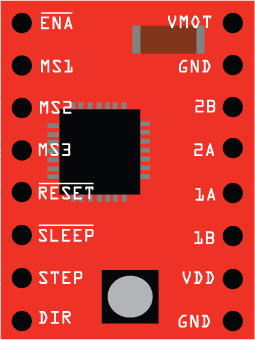
 Design with A4988 Stepper Motor Driver (Red) in Cirkit Designer
Design with A4988 Stepper Motor Driver (Red) in Cirkit DesignerIntroduction
The A4988 Stepper Motor Driver (Red) is a compact and versatile driver module designed for controlling bipolar stepper motors. It features adjustable current control, microstepping capabilities (up to 1/16 steps), and built-in thermal shutdown protection, making it ideal for applications requiring precise motor control. This driver is widely used in 3D printers, CNC machines, robotics, and other motion control systems.
Explore Projects Built with A4988 Stepper Motor Driver (Red)
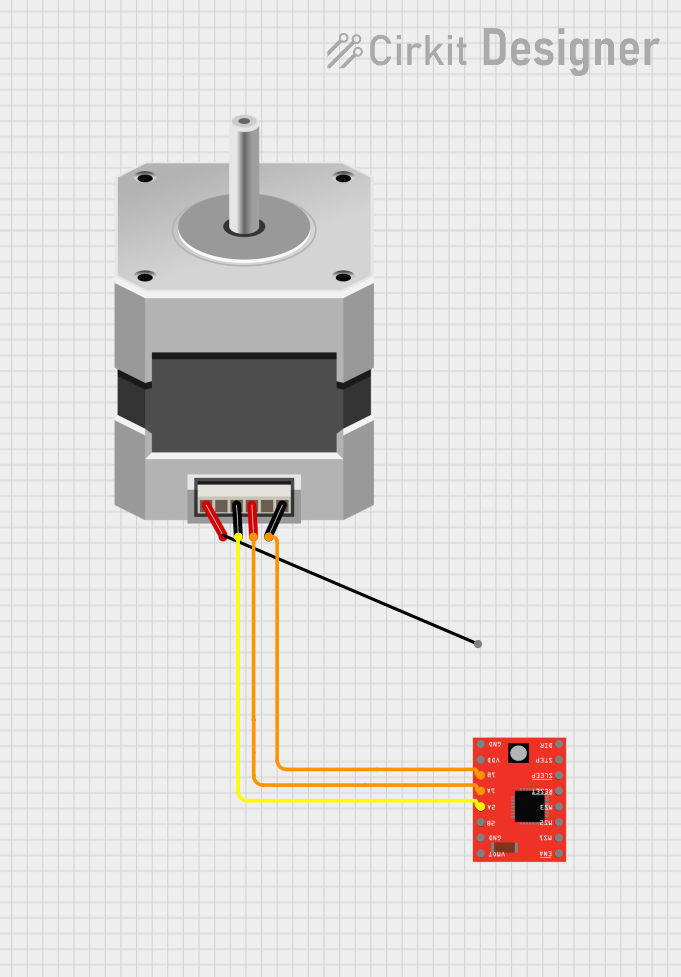
 Open Project in Cirkit Designer
Open Project in Cirkit Designer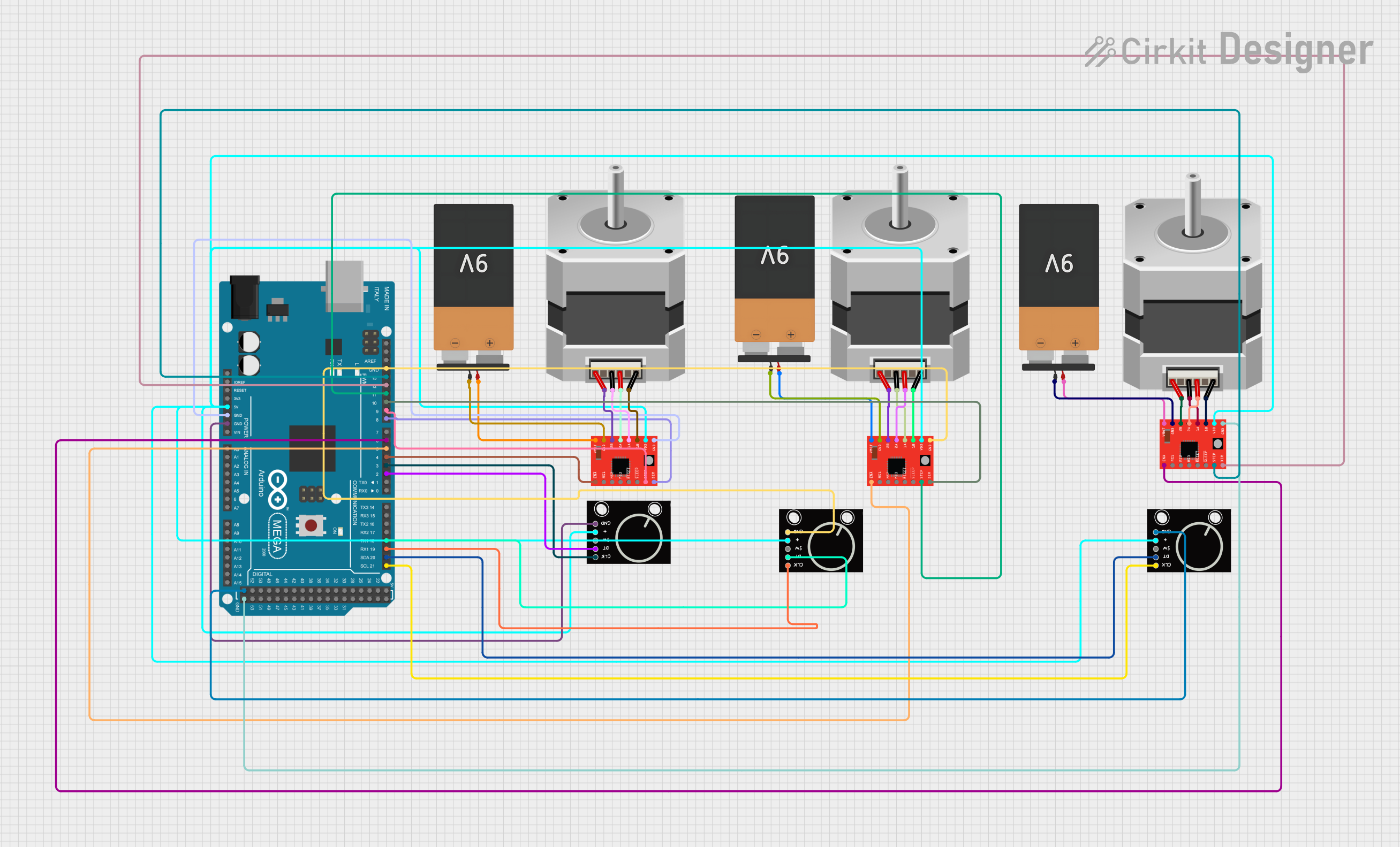
 Open Project in Cirkit Designer
Open Project in Cirkit Designer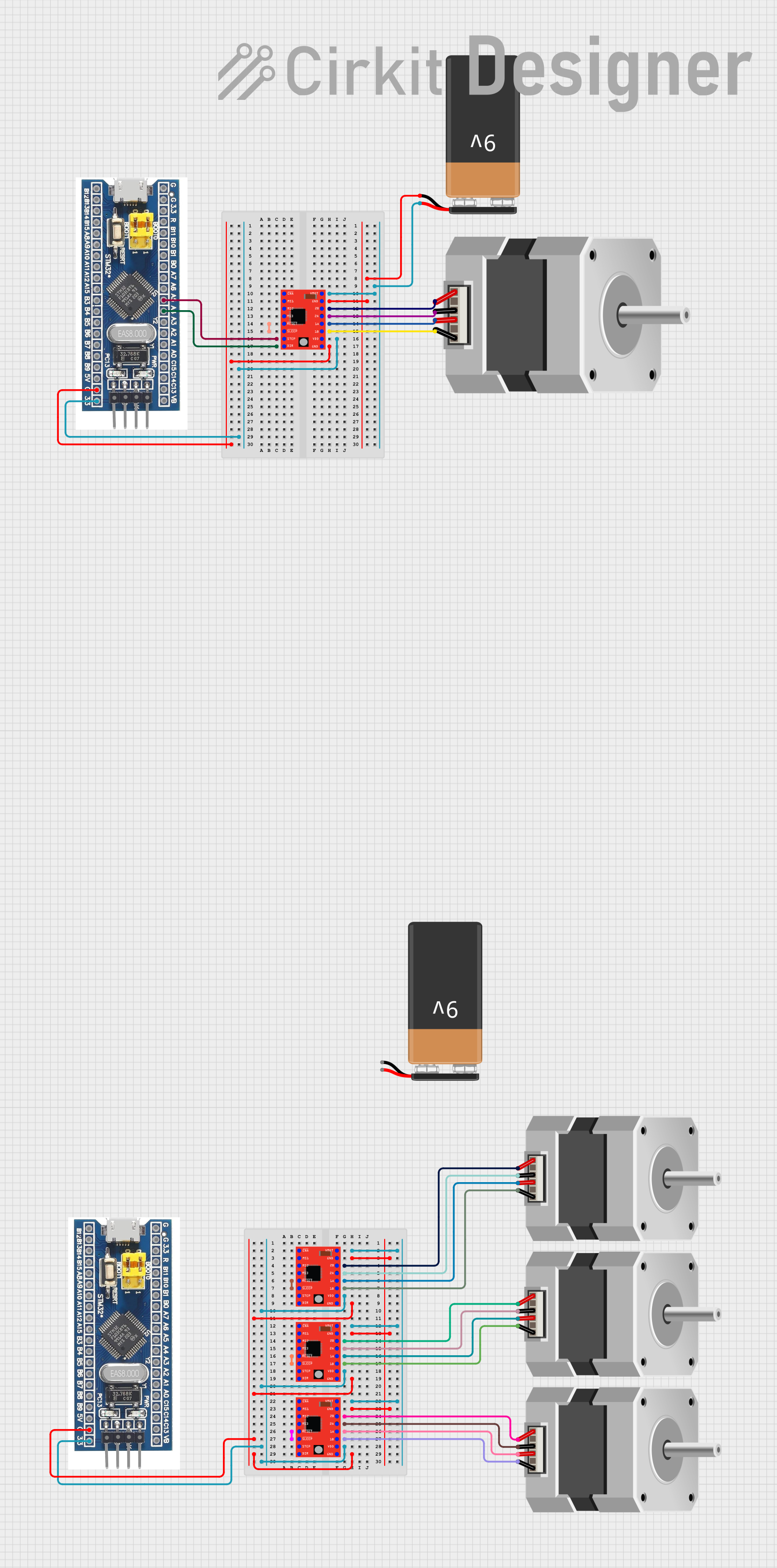
 Open Project in Cirkit Designer
Open Project in Cirkit Designer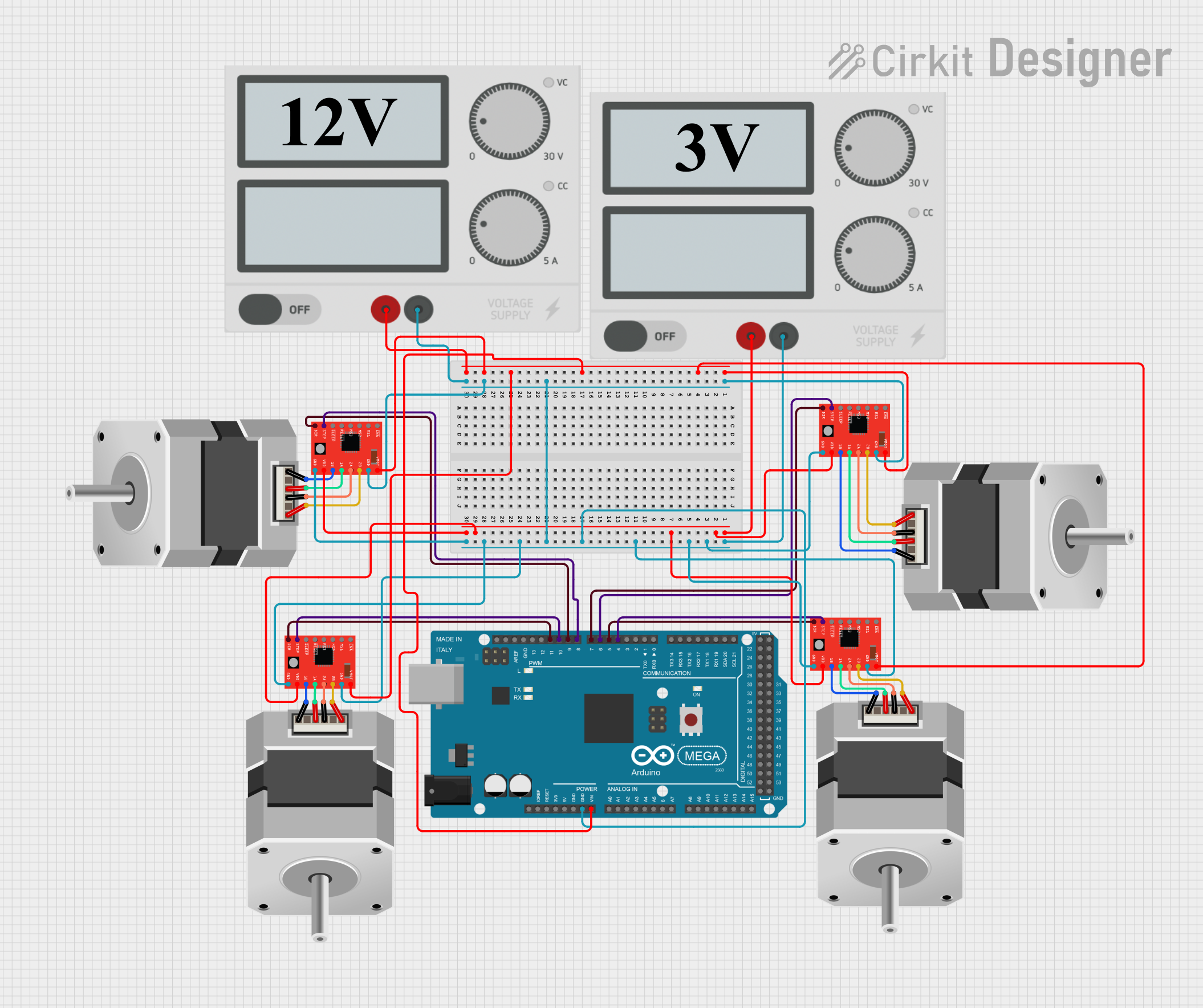
 Open Project in Cirkit Designer
Open Project in Cirkit DesignerExplore Projects Built with A4988 Stepper Motor Driver (Red)

 Open Project in Cirkit Designer
Open Project in Cirkit Designer
 Open Project in Cirkit Designer
Open Project in Cirkit Designer
 Open Project in Cirkit Designer
Open Project in Cirkit Designer
 Open Project in Cirkit Designer
Open Project in Cirkit DesignerCommon Applications
- 3D printers for precise movement of axes
- CNC machines for accurate tool positioning
- Robotics for controlling stepper motors in robotic arms or wheels
- Automated systems requiring stepper motor control
Technical Specifications
Key Technical Details
- Operating Voltage (VMOT): 8V to 35V
- Logic Voltage (VDD): 3.3V or 5V
- Maximum Output Current: 2A per coil (with sufficient cooling)
- Microstepping Modes: Full, 1/2, 1/4, 1/8, and 1/16 steps
- Current Control: Adjustable via onboard potentiometer
- Thermal Protection: Over-temperature shutdown
- Overcurrent Protection: Yes
- Dimensions: 20mm x 15mm x 11mm (approx.)
Pin Configuration and Descriptions
The A4988 module has 16 pins, divided into two sides. Below is the pin configuration:
| Pin Name | Description |
|---|---|
| VMOT | Motor power supply (8V to 35V). Connect to the stepper motor's power source. |
| GND | Ground for motor power supply. |
| 2B, 2A | Outputs for connecting to one coil of the stepper motor. |
| 1A, 1B | Outputs for connecting to the other coil of the stepper motor. |
| VDD | Logic voltage input (3.3V or 5V). |
| GND | Ground for logic voltage. |
| STEP | Input for step signal. Each pulse moves the motor one step. |
| DIR | Input for direction control. High or low determines motor rotation direction. |
| ENABLE | Active-low input to enable or disable the driver. |
| MS1, MS2, MS3 | Microstepping mode selection pins. Configure for full, 1/2, 1/4, 1/8, or 1/16. |
| RESET | Active-low reset input. Resets internal logic when pulled low. |
| SLEEP | Active-low sleep mode input. Pull low to minimize power consumption. |
Usage Instructions
How to Use the A4988 in a Circuit
Power Connections:
- Connect VMOT and GND to the stepper motor's power supply (8V to 35V).
- Connect VDD and GND to the logic power supply (3.3V or 5V).
Motor Connections:
- Connect the stepper motor's two coils to the 1A, 1B, 2A, and 2B pins. Ensure the correct pairing of the motor wires.
Control Signals:
- Connect the STEP pin to a microcontroller's digital output pin for step control.
- Connect the DIR pin to another digital output pin for direction control.
- Optionally, connect ENABLE, RESET, and SLEEP pins to control the driver's state.
Microstepping Configuration:
- Use MS1, MS2, and MS3 pins to set the desired microstepping mode. Refer to the table below:
| MS1 | MS2 | MS3 | Microstepping Mode |
|---|---|---|---|
| Low | Low | Low | Full Step |
| High | Low | Low | Half Step |
| Low | High | Low | Quarter Step |
| High | High | Low | Eighth Step |
| High | High | High | Sixteenth Step |
- Adjusting Current Limit:
- Use the onboard potentiometer to set the current limit. This prevents overheating and ensures safe operation. Turn clockwise to increase the limit and counterclockwise to decrease it.
Example Arduino Code
Below is an example of how to control a stepper motor using the A4988 and an Arduino UNO:
// Define control pins
#define STEP_PIN 3 // Pin connected to STEP
#define DIR_PIN 4 // Pin connected to DIR
void setup() {
pinMode(STEP_PIN, OUTPUT); // Set STEP pin as output
pinMode(DIR_PIN, OUTPUT); // Set DIR pin as output
digitalWrite(DIR_PIN, HIGH); // Set initial direction (HIGH = clockwise)
}
void loop() {
// Generate step pulses
digitalWrite(STEP_PIN, HIGH); // Set STEP pin HIGH
delayMicroseconds(1000); // Wait 1ms (adjust for speed)
digitalWrite(STEP_PIN, LOW); // Set STEP pin LOW
delayMicroseconds(1000); // Wait 1ms (adjust for speed)
}
Important Considerations
- Always set the current limit before connecting the motor to avoid damage.
- Use a heatsink or active cooling if operating near the maximum current rating.
- Ensure proper decoupling capacitors are installed between VMOT and GND to prevent voltage spikes.
Troubleshooting and FAQs
Common Issues and Solutions
Motor Not Moving:
- Check all power and motor connections.
- Verify that the STEP and DIR signals are being sent correctly.
- Ensure the current limit is set appropriately for the motor.
Driver Overheating:
- Reduce the current limit using the potentiometer.
- Add a heatsink or active cooling to the driver.
Motor Vibrating but Not Rotating:
- Verify the correct pairing of motor wires to the 1A, 1B, 2A, and 2B pins.
- Check the microstepping configuration.
Erratic Motor Movement:
- Ensure a stable power supply for both VMOT and VDD.
- Add decoupling capacitors to reduce noise.
FAQs
Can I use the A4988 with a unipolar stepper motor? No, the A4988 is designed for bipolar stepper motors only.
What happens if I exceed the current limit? The driver will enter thermal shutdown to protect itself, but this may cause erratic motor behavior. Always set the current limit properly.
Can I control multiple stepper motors with one A4988? No, each A4988 driver can control only one bipolar stepper motor.
By following this documentation, you can effectively use the A4988 Stepper Motor Driver (Red) in your projects for precise and reliable stepper motor control.